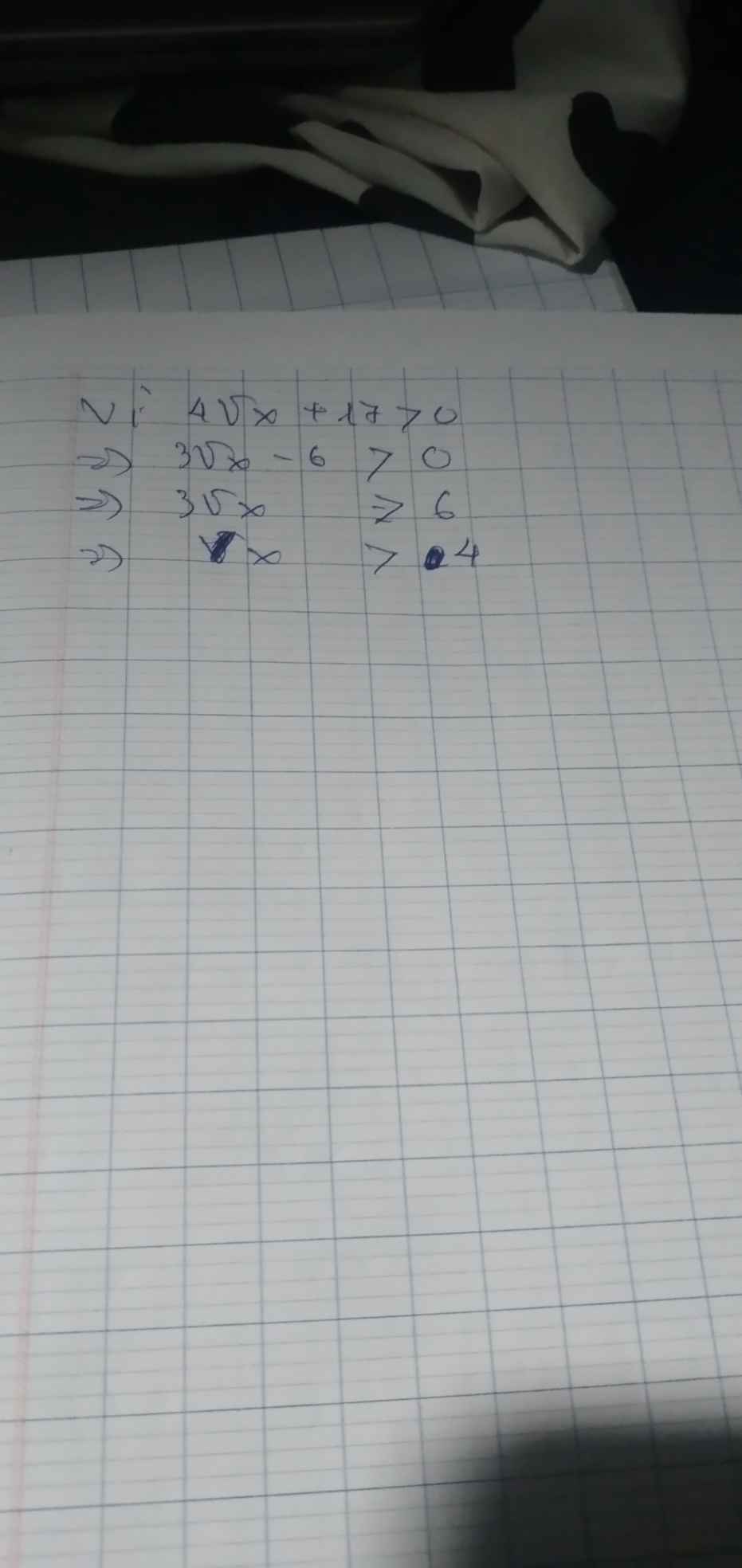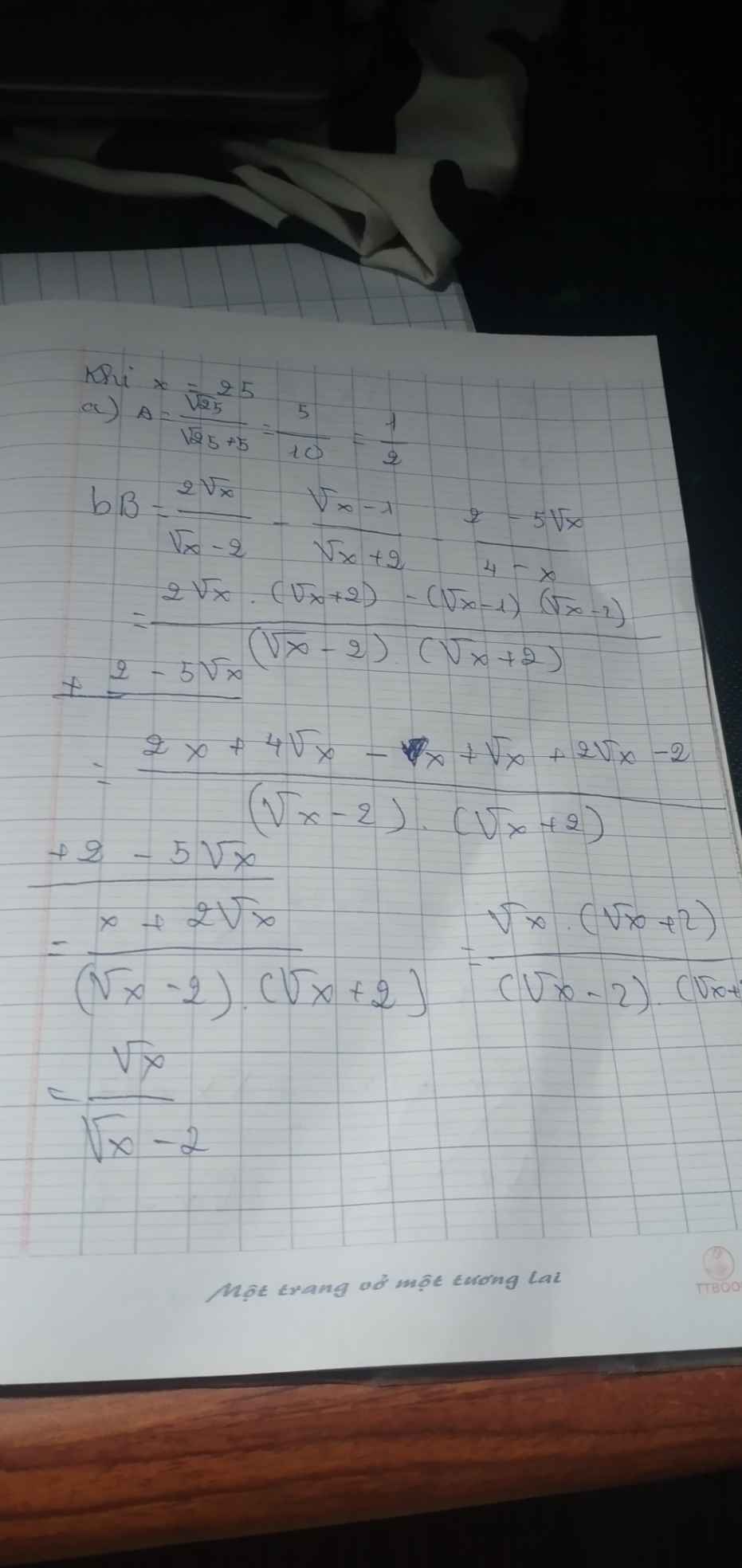Hãy nhập câu hỏi của bạn vào đây, nếu là tài khoản VIP, bạn sẽ được ưu tiên trả lời.

(a) Với \(x\ge0,x\ne4\), ta có:
\(A=\dfrac{2x-3\sqrt{x}-2}{\sqrt{x}-2}=\dfrac{\left(\sqrt{x}-2\right)\left(2\sqrt{x}+1\right)}{\sqrt{x}-2}=2\sqrt{x}+1\)
Để \(A\le5\Rightarrow2\sqrt{x}+1\le5\)
\(\Leftrightarrow2\sqrt{x}\le4\Leftrightarrow\sqrt{x}\le2\Leftrightarrow0\le x\le4\).
Kết hợp với điều kiện thì: \(0\le x< 4.\)
(b) \(\dfrac{A}{2}=\dfrac{2\sqrt{x}+1}{2}\) nguyên khi \(\left(2\sqrt{x}+1\right)\in B\left(2\right)=\left\{0;2;4;...;2n\right\}\left(n\in N\right)\)
\(\Leftrightarrow\sqrt{x}\in\left\{-\dfrac{1}{2};\dfrac{1}{2};\dfrac{3}{2};...;\dfrac{2n+1}{2}\right\}\left(n\in N\right)\)
Hay: \(\sqrt{x}\in\left\{\dfrac{1}{2};\dfrac{3}{2};...;\dfrac{2n+1}{2}\right\}\)
\(\Leftrightarrow x\in\left\{\dfrac{1}{4};\dfrac{9}{4};...;\dfrac{\left(2n+1\right)^2}{4}\right\}\)

P = A.B = \(\dfrac{x-7}{\sqrt{x}+2}=\dfrac{\left(x-4\right)-3}{\sqrt{x}+2}=\dfrac{\left(\sqrt{x}-2\right).\left(\sqrt{x}+2\right)-3}{\sqrt{x}+2}\)
\(=\sqrt{x}-2-\dfrac{3}{\sqrt{x}+2}\)
\(P\inℤ\) <=> x là số chính phương và \(\dfrac{3}{\sqrt{x}+2}\inℤ\)
mà \(\sqrt{x}+2\ge2\Rightarrow\dfrac{3}{\sqrt{x}+2}\inℤ\Leftrightarrow\sqrt{x}+2=3\)
\(\Leftrightarrow x=1\) (thỏa)
Vậy x = 1 thì P \(\inℤ\)

\(a,A=\left(\dfrac{\sqrt{x}}{x-4}+\dfrac{2}{2-\sqrt{x}}+\dfrac{1}{\sqrt{x}+2}\right):\left(\sqrt{x}-2+\dfrac{10-x}{\sqrt{x}+2}\right)\left(dk:x\ge0,x\ne4\right)\\ =\left(\dfrac{\sqrt{x}}{\left(\sqrt{x}-2\right)\left(\sqrt{x}+2\right)}-\dfrac{2}{\sqrt{x}-2}+\dfrac{1}{\sqrt{x}+2}\right):\left(\dfrac{\left(\sqrt{x}-2\right)\left(\sqrt{x}+2\right)+10-x}{\sqrt{x}+2}\right)\\ =\dfrac{\sqrt{x}-2\left(\sqrt{x}+2\right)+\left(\sqrt{x}-2\right)}{\left(\sqrt{x}-2\right)\left(\sqrt{x}+2\right)}.\dfrac{\sqrt{x}+2}{x-4+10-x}\)
\(=\dfrac{\sqrt{x}-2\sqrt{x}-4+\sqrt{x}-2}{\sqrt{x}-2}.\dfrac{1}{6}\\ =\dfrac{-6}{\left(\sqrt{x}-2\right).6}\\
=-\dfrac{1}{\sqrt{x}-2}\)
\(b,A>0\Leftrightarrow-\dfrac{1}{\sqrt{x}-2}>0\Leftrightarrow\sqrt{x}-2< 0\\
\Leftrightarrow\sqrt{x}< 2\Leftrightarrow x< 4\)
Kết hợp với \(dk:x\ge0,x\ne4\), ta kết luận \(0\le x< 4\)

a: Thay \(x=\dfrac{1}{4}\) vào A, ta được:
\(A=\left(\dfrac{1}{2}+1\right):\left(\dfrac{1}{2}-2\right)=\dfrac{3}{2}:\dfrac{-3}{2}=-1\)
b: Ta có: \(B=\dfrac{\sqrt{x}+2}{\sqrt{x}-3}+\dfrac{\sqrt{x}-8}{x-5\sqrt{x}+6}\)
\(=\dfrac{x-4+\sqrt{x}-8}{\left(\sqrt{x}-3\right)\left(\sqrt{x}-2\right)}\)
\(=\dfrac{x+\sqrt{x}-12}{\left(\sqrt{x}-3\right)\left(\sqrt{x}-2\right)}\)
\(=\dfrac{\sqrt{x}+4}{\sqrt{x}-2}\)
c: Để B là số tự nhiên thì \(\sqrt{x}+4⋮\sqrt{x}-2\)
\(\Leftrightarrow\sqrt{x}-2\in\left\{1;2;3;6\right\}\)
\(\Leftrightarrow\sqrt{x}\in\left\{3;4;5;8\right\}\)
hay \(x\in\left\{16;25;64\right\}\)

Ta có : \(P=3A+2B\)
\(=\dfrac{2\sqrt{x}}{\sqrt{x}+2}+\dfrac{3}{\sqrt{x}+2}=\dfrac{2\sqrt{x}+3}{\sqrt{x}+2}.\)
\(\Rightarrow P=\dfrac{2\left(\sqrt{x}+2\right)-1}{\sqrt{x}+2}=2-\dfrac{1}{\sqrt{x}+2}\)
Do \(x\ge0\Rightarrow\sqrt{x}+2\ge0\)
\(\Rightarrow-\dfrac{1}{\sqrt{x}+2}\ge-1\)
\(\Rightarrow P=2-\dfrac{1}{\sqrt{x}+2}\ge-1+2=1.\)
Vậy : \(MinP=1.\) Dấu đẳng thức xảy ra khi và chỉ khi \(x=0.\)

Để A nguyên thì \(2\sqrt{x}-1⋮\sqrt{x}-2\)
\(\Leftrightarrow3⋮\sqrt{x}-2\)
\(\Leftrightarrow\sqrt{x}-2\in\left\{-1;1;3\right\}\)
\(\Leftrightarrow\sqrt{x}\in\left\{1;3;5\right\}\)
hay \(x\in\left\{1;9;25\right\}\)
Tổng các giá trị nguyên của x để A nguyên là 1+9+25=35

Bài 1. ĐKXĐ thêm x ≠ 1 nữa ạ
1) Với x = 9 tmđk, thay vào A ta được : \(A=\dfrac{2\sqrt{9}+1}{9^2}=\dfrac{7}{81}\)
2) \(B=\left[\dfrac{4x}{\left(\sqrt{x}-1\right)}-\dfrac{\sqrt{x}-2}{\left(\sqrt{x}-1\right)\left(\sqrt{x}-2\right)}\right]\cdot\dfrac{\sqrt{x}-1}{x^2}\)
\(=\dfrac{4x-1}{\sqrt{x}-1}\cdot\dfrac{\sqrt{x}-1}{x^2}=\dfrac{4x-1}{x^2}\)
3) Để B < A thì \(\dfrac{4x-1}{x^2}< \dfrac{2\sqrt{x}+1}{x^2}\)
<=> \(\dfrac{4x-1}{x^2}-\dfrac{2\sqrt{x}+1}{x^2}< 0\)
<=> \(\dfrac{4x-2\sqrt{x}-2}{x^2}< 0\)
Vì x2 > 0 ∀ x
=> \(4x-2\sqrt{x}-2< 0\)
<=> \(2x-\sqrt{x}-1< 0\)
<=> \(\left(\sqrt{x}-1\right)\left(2\sqrt{x}+1\right)< 0\)
Vì \(2\sqrt{x}+1\ge1>0\forall x\ge0\)
=> \(\sqrt{x}-1< 0\)<=> x < 1
Vậy với x < 1 thì B < A
Câu 3 :
\(\left\{{}\begin{matrix}x-2y+\dfrac{1}{2x+3y}=2\\2x-4y+\dfrac{3}{2x+3y}=3\end{matrix}\right.\Leftrightarrow\left\{{}\begin{matrix}x-2y+\dfrac{1}{2x+3y}=2\\2\left(x-2y\right)+\dfrac{3}{2x+3y}=3\end{matrix}\right.\)
Đặt \(x-2y=t;\dfrac{1}{2x+3y}=z\)
Hệ phương trình tương đương
\(\left\{{}\begin{matrix}t+z=2\\2t+3z=3\end{matrix}\right.\Leftrightarrow\left\{{}\begin{matrix}t=2-z\left(1\right)\\2t+3z=3\left(2\right)\end{matrix}\right.\)
Thế (1) vào (2) ta được : \(2\left(2-z\right)+3z=3\Leftrightarrow4-2z+3z=3\Leftrightarrow z=-1\)
\(\Rightarrow t=2-z=3\)
hay \(\left\{{}\begin{matrix}x-2y=3\\\dfrac{1}{2x+3y}=-1\end{matrix}\right.\Leftrightarrow\left\{{}\begin{matrix}x=3+2y\left(3\right)\\\dfrac{1}{2x+3y}=-1\left(4\right)\end{matrix}\right.\)
Thế (3) vào (4) ta được : \(\dfrac{1}{2\left(3+2y\right)+3y}=-1\Leftrightarrow\dfrac{1}{6+7y}=-1\Rightarrow-6-7y=1\Leftrightarrow-7y=7\Leftrightarrow y=-1\)
\(\Rightarrow x=3-2=1\)
Vậy \(\left(x;y\right)=\left(1;-1\right)\)




Lời giải:
\(A< \frac{-2}{3}\Leftrightarrow \frac{\sqrt{x}-2}{\sqrt{x}+2}+\frac{2}{3}< 0\)
\(\Leftrightarrow \frac{3(\sqrt{x}-2)+2(\sqrt{x}+2)}{3(\sqrt{x}+2)}<0\)
$\Leftrightarrow 3(\sqrt{x}-2)+2(\sqrt{x}+2)<0$
$\Leftrightarrow 5\sqrt{x}-2<0$
$\Leftrightarrow \sqrt{x}< \frac{2}{5}\Leftrightarrow 0\leq x< \frac{4}{25}$
Kết hợp đkxđ suy ra $0\leq x< \frac{4}{25}$ thì $A< \frac{-2}{3}$